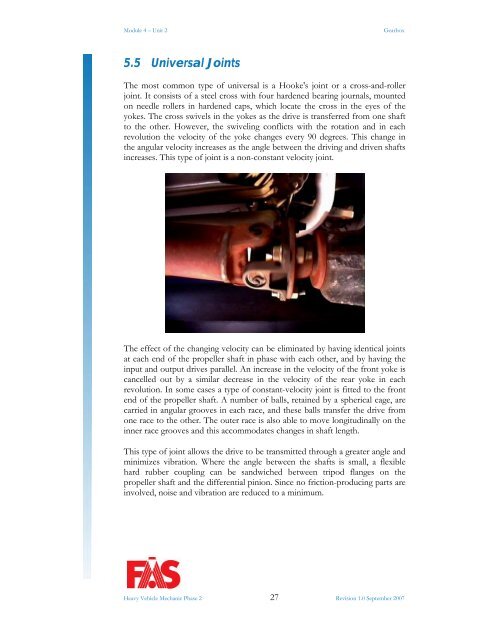TRADE OF HEAVY VEHICLE MECHANIC - eCollege
TRADE OF HEAVY VEHICLE MECHANIC - eCollege
TRADE OF HEAVY VEHICLE MECHANIC - eCollege
You also want an ePaper? Increase the reach of your titles
YUMPU automatically turns print PDFs into web optimized ePapers that Google loves.
Module 4 – Unit 2 Gearbox<br />
5.5 Universal Joints<br />
The most common type of universal is a Hooke's joint or a cross-and-roller<br />
joint. It consists of a steel cross with four hardened bearing journals, mounted<br />
on needle rollers in hardened caps, which locate the cross in the eyes of the<br />
yokes. The cross swivels in the yokes as the drive is transferred from one shaft<br />
to the other. However, the swiveling conflicts with the rotation and in each<br />
revolution the velocity of the yoke changes every 90 degrees. This change in<br />
the angular velocity increases as the angle between the driving and driven shafts<br />
increases. This type of joint is a non-constant velocity joint.<br />
The effect of the changing velocity can be eliminated by having identical joints<br />
at each end of the propeller shaft in phase with each other, and by having the<br />
input and output drives parallel. An increase in the velocity of the front yoke is<br />
cancelled out by a similar decrease in the velocity of the rear yoke in each<br />
revolution. In some cases a type of constant-velocity joint is fitted to the front<br />
end of the propeller shaft. A number of balls, retained by a spherical cage, are<br />
carried in angular grooves in each race, and these balls transfer the drive from<br />
one race to the other. The outer race is also able to move longitudinally on the<br />
inner race grooves and this accommodates changes in shaft length.<br />
This type of joint allows the drive to be transmitted through a greater angle and<br />
minimizes vibration. Where the angle between the shafts is small, a flexible<br />
hard rubber coupling can be sandwiched between tripod flanges on the<br />
propeller shaft and the differential pinion. Since no friction-producing parts are<br />
involved, noise and vibration are reduced to a minimum.<br />
Heavy Vehicle Mechanic Phase 2 27 Revision 1.0 September 2007
















